Sep 2, 2020 | Communication, Sustainable Development, Systems Analysis
By Rachel Potter, Communications Officer in the IIASA Communications and External Relations Department.
Several members of the IIASA Strategic Taskforce share their views on the bold new IIASA strategic agenda, how it came to be, and what it promises for the future.
What will the world look like in 2030 and beyond? We are living in extraordinary times and our rapidly transforming planet faces multiple global sustainability challenges, threats, and opportunities. How will research institutes like IIASA continue to make meaningful contributions to address these complex issues?

This is precisely what IIASA has been exploring over the past 18 months while formulating its strategic direction for the next 10 years. Through institute-wide consultations, a strategic taskforce was entrusted with coordinating the process that led to “Reducing footprints, enhancing resilience” – the institute’s ambitious new strategy for 2021-2030 that positions IIASA as the primary destination for integrated systems solutions and policy insights.
A bottom-up inclusive approach
The strategy consultation process was very different to those previously undertaken at IIASA. Acting Transitions to New Technologies Program Director and Energy Program researcher, Shonali Pachauri describes the rationale behind the process:
“While in the past strategic planning had largely been driven by the directorate and program directors, this time, mid-career scientists were to drive the process forward. It was not meant to be one researcher from each program on the taskforce, but it ended up being something like that, so we had a broad representation of disciplines from across the institute. The taskforce was responsible for developing the scientific content of the plan and we did this in an inclusive manner with input from staff through workshops, an online platform, and both informal and formal meetings.”
Reflecting our changing world
The UN Sustainable Development Goals (SDGs) established in 2015, are clearly reflected in the new strategy. Linda See, a researcher in the Ecosystems Services and Management Program, explains:
“We have always worked on sustainable development and transformations but this is now more of a focus compared to the previous strategy. The emphasis is on using our expertise as systems scientists to explore the interrelationships between different SDGs and how there can be synergies and trade-offs in different scenarios to achieve them.”
“Another key shift is that the new strategic plan takes a human-centered approach, placing more emphasis on how people are a core component of pathways towards sustainability and resilient societies,” adds World Population Program Deputy Program Director, Raya Muttarak.
Fellow taskforce member and Acting Water Program Director, Yoshihide Wada, agrees:
“This focus on social science, governance, and human behavior came out of our consultations with staff. IIASA researchers really want to go in this direction. People increasingly understand that with the climate and environmental goals in particular, it can’t only be technology and bioeconomy, it has to be about lifestyles as well, which means we need to strengthen our ability to analyze behavior and identify which levers to pull to encourage lifestyle changes.”
“There is also a stronger focus on biodiversity. The importance of this was borne out of the current COVID-19 crisis. Looking at the origin of the virus and how the pandemic has been aided by the loss of biodiversity – it’s evident that this is crucial,” adds Manager of Library and Knowledge Resources, Michaela Rossini.
Building on strong foundations for continued innovation
Taskforce members agree that the new strategy consolidates the unique strengths of IIASA while providing the space and flexibility for innovation.
“IIASA is unique not only because of our excellence in the fields of energy, environment, climate change, and ecosystems services but also because we have strong, empirically-based analyses and studies from social sciences, which can quantify and forecast relevant demographic, social, and economic dimensions in systems analysis,” says Muttarak.
“I think the new strategy pushes the interdisciplinarity at IIASA even further. The new program structure is very integrated. This is vital to facing today’s sustainability challenges. There are big aspirations in the strategy and it’s our responsibility to translate this into practice. As scientists, we have to be open to change and include elements that we may never have thought of. It makes things very interesting. It makes innovation happen,” Wada adds.
Pachauri explains that IIASA was created as a science-to-policy interface in 1972 and its purpose has always been to bridge divides: both between disciplines and across transnational boundaries. The new strategy really builds on this history. While the institute innovates a lot in terms of models and methods, this always happens through an applied lens of doing something that will ultimately feed into policy.
One of the institute’s key strengths is its relationships with its National Member Organizations and strong global network. These relationships are what make it possible to tackle the real-world problems society faces today. The flexibility to work across networks, countries, and different levels of government is strongly emphasized in the strategy.
A bit like family
According to Muttarak, the process of drawing up the new IIASA strategy has been a great opportunity to work with people from different programs and units. Not only has this allowed everyone involved to get to know their colleagues better, but it has also enhanced team members’ understanding of systems analysis and the importance of IIASA.
“It was challenging and rewarding, a bit like family!” comments Pachauri. “There was a lovely dynamism in the team and although we had a Chair, everyone had a chance to lead at various times in the process.”
“As the only non-scientist I found working on the taskforce invaluable – understanding more about IIASA research and getting to know scientists from across the institute has really enhanced my awareness of what they do and what their needs are going forward,” Rossini concludes.
The full IIASA Strategic Taskforce is comprised of: Luis Gomez Echeverri, Matthias Jonas, Mauricio A. Lopes, Junko Mochizuki, Raya Muttarak, Shonali Pachauri, Michaela Rossini, Linda See, Thomas Schinko, Yoshihide Wada, and Fabian Wagner.
Note: This article gives the views of the author, and not the position of the Nexus blog, nor of the International Institute for Applied Systems Analysis.
Apr 29, 2020 | Austria, COVID19, Systems Analysis
By Tamás Krisztin, researcher in the IIASA Ecosystems Services and Management Program
Tamás Krisztin discusses the air travel restrictions instituted by governments across the globe and how effective they really are in terms of curbing the spread of COVID-19.

© Potowizard | Dreamstime.com
Many Western countries are reaching, or have reached, the peak of COVID-19 infections, and policymakers are increasingly turning their attention to the next critical question: how to lift lockdown restrictions responsibly, while at the same time making sure that trade and travel can be restored to as close to “normal” as possible? Our research indicates that stoppage of airline traffic and border closures, which were some of the first modes of transport to be restricted, should also be some of the last to be restored because of their critical role in spreading infections.
Governments began to restrict airline traffic at the end of January this year, and by 21 March, over half of the EU had implemented flight suspensions. Our research confirms that this was a timely and necessary step. In the early stages of the pandemic, international flight linkages were actually the main transmission channel for the virus. In fact, flight connections proved to be an even more accurate predictor of infection spread between two countries than the presence of common land borders or trade connections. As country after country enacted travel bans, our research also shows a corresponding decrease in cross-country spillovers of the virus.
In Austria, for instance, our model demonstrates that if the shutdown of cross border traffic (flight connections and car border crossings) had been delayed by only 16 days, (25 March instead of 10 March), about 7,200 additional people would have been infected (see Figure 1).
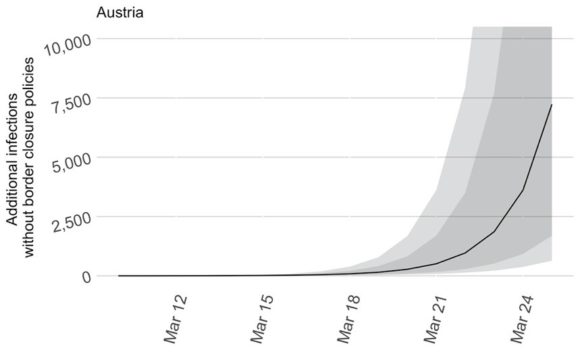
Figure 1: Additional infections in Austria without border closures (Note: Shaded areas correspond to the 68th and 90th quantiles, respectively).
Additionally, our modeling shows the increased importance of flight connections over the initial period of the crisis, as seen in Figure 2. The top panel visualizes the relative importance of connectivity measures and demonstrates that, particularly in the beginning phases of the pandemic, flight connections were of the highest importance. The bottom panel shows infection spread between countries. Around the middle of March, when most border closure policies were implemented, the line drops to zero, indicating that these measures significantly reduced cross-border infections.

Figure 2: Importance of connectivity (top panel) and spatial spillovers (bottom panel)
Given the importance of air travel as a means for transmission of COVID-19, it stands to reason that governments and policymakers will have to continue to restrict air travel to prevent a second wave of the virus. As some parts of the world begin slowly to lift restrictions and ease lockdowns, while others are only now beginning to near the peak of the pandemic, it is likely that air travel will continue to be severely limited to prevent cross-border spread.
Note: This article gives the views of the author, and not the position of the Nexus blog, nor of the International Institute for Applied Systems Analysis.
Aug 27, 2019 | Climate Change, Environment, Risk and resilience, Young Scientists
By Luiza Toledo, IIASA Science Communication Fellow 2019
2019 YSSP participant Regina Buono investigates how the law can support or impede the use of nature-based solutions and help facilitate adaptation to climate change.
Recognizing the need for a systemic change is the first step to overcoming environmental challenges like climate change. In theory, governance systems can be designed and arranged to facilitate and embrace adaptation to climate change. Developing a legal framework that supports such an adaptation is, however, a big challenge. Learning how to manage the environmental crisis we currently find ourselves in while still being able to grow economically further complicates matters. According to Regina Buono, a participant in this year’s IIASA Young Scientist Summer Program (YSSP), nature-based solutions could be an alternative option that offers a multitude of benefits in terms of how this dual goal of economic growth and sustainability can be achieved. Buono’s research will contribute to IIASA as a partner in the EU Horizon 2020 project, PHUSICOS, which is demonstrating how nature-based solutions can reduce the risk of extreme weather events in rural mountain landscapes.
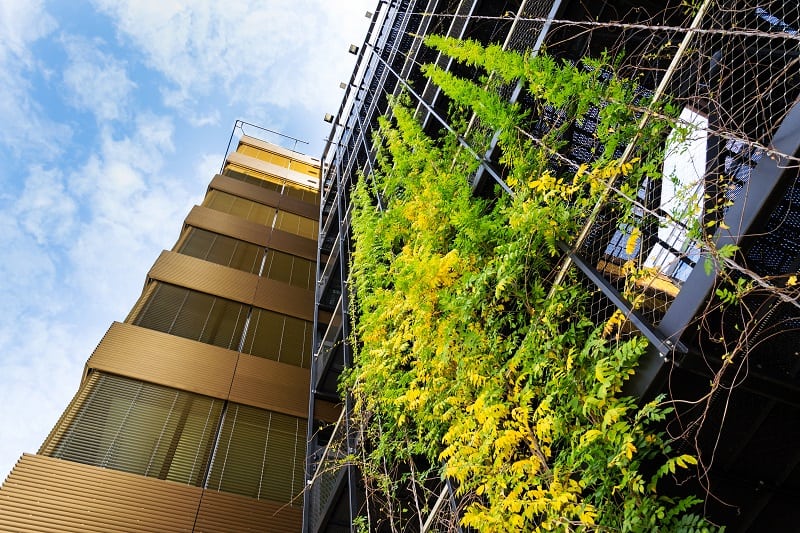
Outdoor green living wall, vertical garden on modern office building | © Josefkubes | Dreamstime.com
Nature-based solutions are actions to protect, manage, or restore natural ecosystems that address societal challenges, such as water security, pollution, or natural disasters – sometimes simultaneously. These solutions take advantage of the system processes found in nature – such as the water regulation function of wetlands, the allowance of natural space in floodplains to buffer flooding impacts, water storage in recharged aquifers, or carbon storage in prairies – to tackle environmental problems. This concept is now widely used to reframe policy debates on biodiversity conservation, climate change adaptation and mitigation strategies, urban resilience, as well as the sustainable use of natural resources.
As part of her research, Buono is exploring how the law can support or impede the use of nature-based solutions and considering how we can make legal systems more adaptive so they can help facilitate societal adaptation to a more uncertain world under ongoing and future climate change.
“My research is about using the law as a tool that works for us, rather than one that, because of its historic interest in stability, gets in the way,” she says.
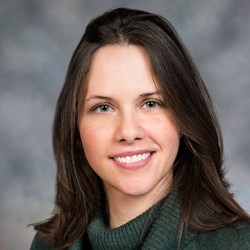
Regina Buono, YSSP participant. | © Buono
Buono started her career as a lawyer based in the US. In her first job she was assigned to work with water issues and according to her, it was “love at first sight”. Following that first assignment, she continued to work on finding market-based solutions for issues related to endangered species. She decided to pursue a PhD in public policy in 2016, and soon after was asked to join the external advisory board to the Nature Insurance Value: Assessment and Demonstration (NAIAD) project in Europe. While attending the first meeting, she realized that there were no lawyers or legal scholars among the project researchers. As a lawyer, she could see that there was a gap in understanding how law and regulations would impact the uptake, development, and proliferation of nature-based solutions.
Working with NAIAD, she developed her PhD dissertation to address this gap and advance understanding around the role of the law in nature-based solutions, both in terms of governance in implementation and practice and the potential for governance innovation that better supports and promotes future adaptation.
“My YSSP project here at IIASA focuses on the city of Valladolid, Spain, and examines the legal context around the implementation of a collection of nature-based solution projects. I am trying to draw insights from these that could perhaps also be applied to other cases,” she explains.
Buono is doing a critical qualitative study that integrates analyses of interviews and policy documents using NVivo, a qualitative data analysis computer software package specifically designed to work with very rich text-based and/or multimedia information, together with legal analysis. She says that there is still a lot of work to be done to adapt to climate change and an interdisciplinary cross-sector effort will be necessary.
The preliminary results from her YSSP research point to a number of constraints and facilitating factors related to law and regulation. She says that the lack of explicit legal authorization for nature-based solutions that she identified in her study, strict water quality regulations, and bureaucratic hurdles could be some of the factors that constrain the implementation of nature-based solutions. However, flexibility in the law and a polycentric governance structure was identified as facilitating factors that encourage local entities to opt for nature-based solutions.
Buono hopes that her research will help decision makers to assess and address legal components that guide, structure, or impede the use of nature-based solutions, and to consider how the law could be evolved to create a more enabling environment for more adaptive governance arrangements that would better support nature-based solutions.
“Our policies and infrastructure are going to have to change to be able to deal with the impacts that we are already experiencing. Nature-based solutions and a shift toward adaptive governance could help us navigate more gracefully in these important transitions,” she concludes.
Note: This article gives the views of the author, and not the position of the Nexus blog, nor of the International Institute for Applied Systems Analysis.
Jul 31, 2019 | Alumni, IIASA Network, India, Women in Science
By Nandita Saikia, Assistant Professor of Population Studies at Jawaharlal Nehru University, New Delhi, and former postdoctoral researcher at IIASA
IIASA alumna Nandita Saikia, looks back on the two years that she spent living in Austria while working as a postdoctoral researcher in the World Population Program.
The submission of my PhD thesis, marriage, taking up a university position, and becoming a mother, all happened rather quickly for me. By the time I realized that I wanted to experience working outside of my own country, a good five years had flown by from the day that I received my PhD. For a female academic, who is trying to balance family and work, a decision to move abroad was never going to be easy. It needed a lot of planning, not only in terms of the research topic that I wanted to pursue, but also in terms of organizing things in a way that would lead to the least disruption for the research students I was supervising and of course, my family.
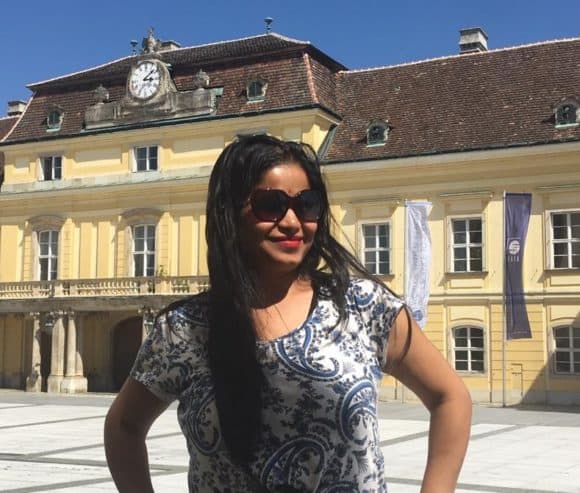
Nandiita Saikia | © Nandita Saikia
With little hope and many conditions, I searched for postdoctoral positions on the websites of various institutes. I was amazed when I found an advertisement for a postdoc position at IIASA, which mentioned that it had extended application deadlines for another 18 months – specifically to accommodate female candidates on maternity leave. This gender sensitive rule made my application possible, and ultimately gave me a rich experience and memories that I will cherish forever.
Looking back at the past two years at IIASA, a long list of reasons why this was such an amazing time of my and my family’s lives, comes to mind. The institute is housed in a beautiful two hundred and seventy five year old castle in Laxenburg just outside of Vienna. As an IIASA employee, my family and I could access the green imperial park once meant for Austria’s iconic empress Sissi, at any time. Apart from massive, century old trees that may have shaded Sissi on her own visits, the park contains a spring, a waterfall, and a lake with numerous monuments to Austrian royal families that frequented it over the centuries. The lush green trees, the musical sound of the spring, together with chirping wild ducks and swans, the Laxenburg castles, the tall yellow church under the deep blue sky – all constantly stimulated the spirit of a nature lover like me.
In terms of the more practical aspects of working at IIASA, staff from administration were always available to address all our personal and professional issues efficiently and warmly. We were supported with everything from extending our visas, finding a suitable place to live, and communicating with my son’s school in German, to locating the right physician. The IIASA Communication Department also helped me to convey the meaning of my research in “non-technical language” to a wider audience, for whom the findings are ultimately meant.
The soul of IIASA is truly international and inter-disciplinary. From North to South, East to West, I met colleagues from all parts of the world. The overall research environment is conducive to doing quality research. Our program director, Wolfgang Lutz, extended all possible support for me to stay at IIASA for two years. I however still had enough freedom to manage my responsibilities in terms of the supervision of my PhD students back in India.
IIASA always encourages its employees to be active and fit and supports them to do this in numerous ways. There are a number of clubs and activities on offer, including yoga, a music club, a running club, a swimming club, cycling, German lessons, aerobics, and a tennis club. The institute also maintains a gym for staff members. Some of my colleagues even kept workout clothes in the office for when they could manage to participate in some of these activities amidst their busy schedules. Although it was of course not possible to be in all the clubs, you had a choice, which contributed to the overall “feel good” environment. Being an international research organization, IIASA celebrates the different cultures of its staff members by organizing themed social gatherings like Asia Day, Latin American Day, Canada Day, and Mediterranean Day, to name a few, during which staff have the chance to taste authentic homemade cuisines and see cultural music or dance performances by colleagues. My heart knew no bounds when I got a chance to perform a Bollywood number and an Indian folk dance with my international colleagues!
I also developed an affinity with the IIASA Women in Science Club, which often organized “Meet, Greet and Eat” sessions during which we had the opportunity to interact with established women scientists in an informal way. It was indeed an eye opener to learn about how they overcame common challenges either in their early or later careers.
During our stay, we fully experienced life in Vienna, which has repeatedly been ranked as the best city in the world to live in. The centrality of Vienna also helped us to explore many neighboring countries. In our second year, we lived in Laxenburg where we felt very much at home. We loved how smoothly the little town runs while offering everything needed for a high quality life when raising young children.
Our time at IIASA was extremely productive, but we still felt as if we were in Vienna for a two-year long vacation! If someone asks me whether they should consider IIASA for a post doc or the Young Scientists Summer Program, my answer will be: “Yes, don’t even think twice!”
Nandita Saikia was a postdoctoral researcher at IIASA from 2017 to 2019. More information available at www.nanditasaikia.com.
Note: This article gives the views of the author, and not the position of the Nexus blog, nor of the International Institute for Applied Systems Analysis.
Jul 27, 2018 | Science and Art
by Merlijn Twaalfhoven
Composer Merlijn Twaalfhoven co-created the IIASA session: Courage – A dance science performance debate about sustainable futures by Gloria Benedikt who leads the Art and Science Project at IIASA, at the EuroScience Open Forum in Toulouse. He tells us more about how this merging of worlds can create new bridges between art, science, and societal issues.
An urgent need for better questions
There I was, an artist invited to the largest conference on science and innovation in Europe – the EuroScience Open Forum, commonly referred to as ESOF. Amidst showcases and lectures about robotics, space exploration, and gene technology, I could share my ideas about the connection between art and science.
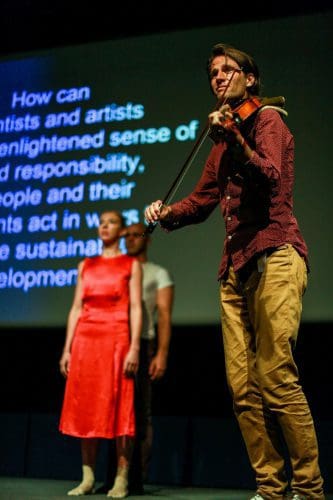
Merlijn Twaalfhoven, © Guillaume Gimenez
This topic can easily become filled with abstractions or generalities. It is true that science and art are both about creativity and research, but is there a concrete way for them to find each other? Is there urgency to bridge these two worlds? The answer to both these questions is a resounding yes.
Different eyes
Art and science are like children that always loved to play together. The worlds of both are filled with curiosity, take steps into the unknown, and embrace uncertainty and adventure. Both are not satisfied with the answers that are provided, and keep asking questions – obsessed with what is below the surface, beyond the horizon, and beneath the solid ground of our convictions.
These two children have much in common, yet they have different eyes, they see things differently. While observing the same world, they pose different questions.
One would ask, ‘What is this?’, ‘How did it become this way?’ and ‘Why is this the way it is?’ While the other asks, ‘What might this also be?’, ‘How can we see this differently?’ and ‘What will this be if…?’
Art and science have always learned and grown together, but over the last few centuries, they have started to grow more and more apart. We might say they have grown up. They each developed their curiosity and creativity into diligent practices and professional attitudes, and started to work within strict disciplinary boundaries. The playfulness and free experimenting sadly transformed into competition and a fixation on what they call “excellence”.
Who is asking the questions?
Today, while global warming, inequality, digitalization, and migration bring instability and change to our societies and global mindsets, there is an urgent need for answers, reliability, and guidance.
Leaders of all kinds, including artists that might influence the way we feel and scientists that might direct the way we reason, are pressed to give such answers. We all add our answers to platforms and channels of news, opinion, soundbites, and statements. It is a cacophony. A flood without structure.
Nevertheless, do we actually know who is asking the questions? Is it the entertainers, talk show hosts, and commercial news media? Will we let the most dominant voices define the big questions of our time? Or can we bring better questions built on the observations, insights, and intuition of artists and scientists to the surface?
Show, don’t talk
We know what the big challenges in society are, and the urgent steps needed to prevent catastrophic global warming, societal polarization, and mass migration are well defined. But how do we, as curious, experienced, and highly trained artists, scientists, researchers, and explorers join forces to make the urgent and engaging questions become not just loud and clear, but part of everybody’s daily reality? Can we not just write or talk about warnings and concerns, but rather create and build questions that ask for a vision that is attractive and beautiful – a way forward that we can experience directly and that makes all of us want to make the world great again?
Beauty
A first step is to find beauty in the world around us. Instead of asking, ‘Why are these people poor?’ we can ask, ‘What makes you proud?’ Instead of asking, ‘How do we stop people from buying cars?’ we can ask, ‘How can I relieve you from the burden of owning (cleaning, insuring, repairing) a car?’ Instead of asking, ‘Why are people unhealthy?’ we can ask, ‘When do you feel free of stress?’
Imagination
A second step is to design ways to express this beauty and to imagine new possibilities. How can we show others the pride you feel? What is the value you get when you do not own a car? What does a stress-free moment sound like?
Play
A third step is to connect people to a changing and evolving reality in playful and challenging ways. What makes your pride contagious to others? How do we practice freedom from possessions? How do we build moments of stress-free time into a rhythm?
These are only a few examples of how art can expose beauty in urgent research topics, create forms of expression to give new ideas presence, and build living and changing structures where a new scientific/artistic mindset may flourish.
What will be the laboratories in which we develop and explore new questions? When will these grownups – art and science – decide to approach each other again, remember their playful childhood, and fall in love all over again? It might be a fruitful affair and give birth to a new mindset that can help us face today’s challenges.

Thank you: In writing this text, I received some valuable contributions from Gloria Benedikt and Anne Glover.
Note: This article gives the views of the authors, and not the position of the Nexus blog, nor of the International Institute for Applied Systems Analysis.










You must be logged in to post a comment.